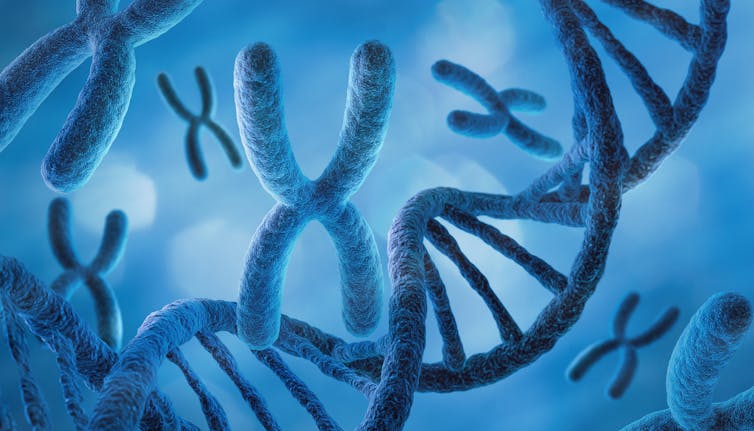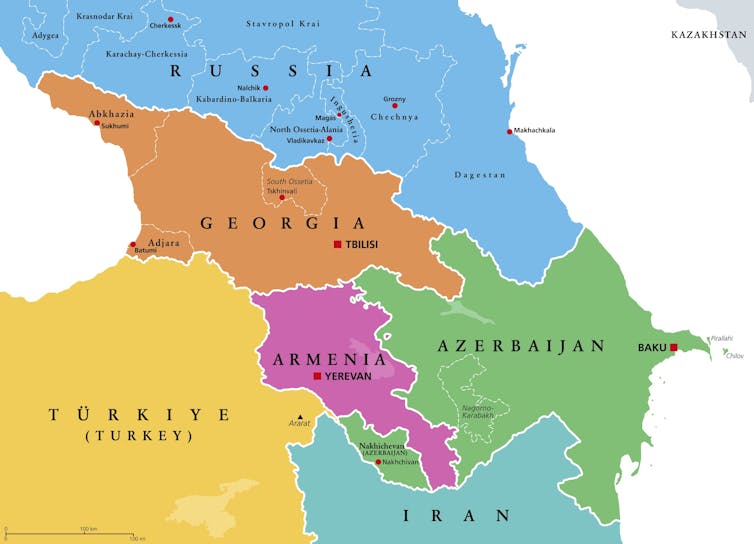Source: The Conversation – UK – By Martin Graff, Senior Lecturer in Psychology of Relationships, University of South Wales
Love is Blind UK returns to Netflix on August 13. For those who haven’t seen it, the show describes itself as a “social experiment” in which single men and women look for love and some get engaged – all before meeting each other in person.
Participants spend the first ten days of the experiment entering various “pods” – small individual rooms containing a sofa and a shared wall with another pod, through which they talk to – but cannot see – their potential matches. If they feel after a series of dates that they have fallen in love with another participant, they can propose marriage.
If accepted, they can then meet their partner in the flesh. Engaged couples are all sent to a resort for a week in order to become more familiar, before moving in together and deciding whether to get married in the show’s final episode.
Some of the couples who met and married on the show have had success. Bobby and Jasmine, and Benaiah and Nicole from the last season of Love is Blind UK are still happily married. Lauren and Cameron from season one of Love is Blind US are currently expecting their first child. But, for many more couples, the show does not lead to lasting love.
The show’s ultimate test is whether people are able to establish an emotional connection strong enough to propose marriage before they have actually met in person. But is talking alone enough for people to really fall in love? Here’s what the research says.
A major component of romantic relationship development is what researchers call “reciprocal self-disclosure”. This basically means gradually revealing information about yourself to your partner, while listening to your partner reveal information about themselves.
Such disclosure initially involves the sharing of superficial information (what’s your favourite colour? Do you have any pets?) and progresses to disclosure of intimate and very intimate information. However, in interactions where we are unable to visually monitor the other person’s nonverbal feedback, we are unaware of subtle cues of approval or disapproval on disclosing information, which can cause misunderstanding.
One of the consequences of this is that an interaction may become more uninhibited. In the security of the Love is Blind pods, people may begin to reveal more intimate information about themselves at a faster rate than normal. Sharing intimate experiences early on in an interaction can actually expedite a degree of intimacy by creating a connection with the other person. But is this really love?
Dating today can feel like a mix of endless swipes, red flags and shifting expectations. From decoding mixed signals to balancing independence with intimacy, relationships in your 20s and 30s come with unique challenges. Love IRL is the latest series from Quarter Life that explores it all.
These research-backed articles break down the complexities of modern love to help you build meaningful connections, no matter your relationship status.
Whether or not Love is Blind’s cast become engaged or not may depend on their attachment styles. “Attachment style” refers to the way in which we became attached to our primary caregivers in infancy and continue that pattern on to later life, affecting the way we become attached to romantic partners.
The three principal styles of attachment are secure, avoidant or anxious. Participants on Love is Blind who have an anxious attachment style may feel increased pressure to settle for a partner than those more securely attached. When this is coupled with the time limit allowed for finding a partner it may result in some imprudent partner choices.
Furthermore, the lack of visual information afforded to Love is Blind participants means that they have to “fill in the gaps” regarding their date, which leads to a degree of imagining or fantasising.
One parallel to the love experienced by the show’s participants is the love victims report feeling for dating site scammers. Many victims say that they feel a sense of love for the scammer, which is why they part with money – although in reality they are merely experiencing a type of love illusion.
A person’s physical appearance, personality and habits, are never totally apparent until a first meeting. This leads to the possibility that people feel less satisfied than they expect on a first face-to-face encounter. This devaluing effect is caused by daters projecting their idea of their ideal partner on to the person with whom they have been talking. Sometimes they may not live up to expectations on first meeting.
We know from research that men rely mainly on physical appearance when evaluating a potential date more than women. Women are more likely to assess additional factors such as ambition and financial resources and also a willingness to invest in children – information which could potentially be ascertained through talking with dating partners.
Furthermore, women generally take longer to decide whether or not they are attracted to a potential date which is related to what has been termed “error management theory”. In essence it means that making an error in choosing the wrong person can be more costly to women. This is maybe why, in heterosexual couples, men are more likely than women to declare love first.
The modality switch
“Modality switching” is the research term for the moment the Love is Blind participants move from chatting in the pods to meeting face-to-face and it is important to understand what predicts success here.
Research from 2017 found that there are three key elements when moving from online dating to face-to-face dating. First, perceiving that a potential partner is similar, second overtly expressing this similarity to them and third the amount of information sought from a potential partner, which serves to reduce uncertainty about them on meeting face-to-face. The situation in Love is Blind is similar to an online date in as much as contestants have not yet met in person.
Love has been the subject of literature, poetry and music as well as the focus of psychological and biological research, and yet a conclusive definition and proper understanding of romantic love remains elusive. Some insight offered by psychologist Robert Sternberg’s “Triangular Theory of Love” suggests that true love comprises of intimacy, passion and commitment – all of which develop over time, not ten days in a pod.
Overall, the evidence suggests that though encouraging disclosure and fantasy combined with prompting a sense of urgency in finding a partner the show appears to facilitate romantic love, in most cases real love takes time together to develop.
Looking for something good? Cut through the noise with a carefully curated selection of the latest releases, live events and exhibitions, straight to your inbox every fortnight, on Fridays. Sign up here.
![]()
Martin Graff does not work for, consult, own shares in or receive funding from any company or organisation that would benefit from this article, and has disclosed no relevant affiliations beyond their academic appointment.
– ref. Love is Blind returns – but is there truth to the show’s ‘social experiment’? Here’s what the research says – https://theconversation.com/love-is-blind-returns-but-is-there-truth-to-the-shows-social-experiment-heres-what-the-research-says-262557





